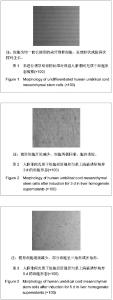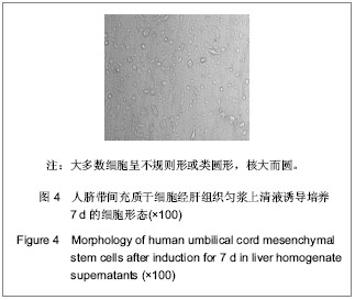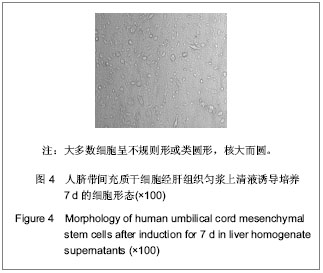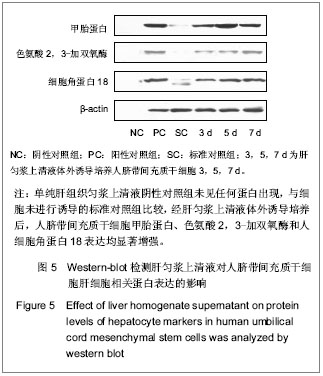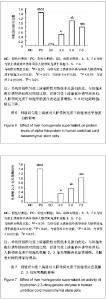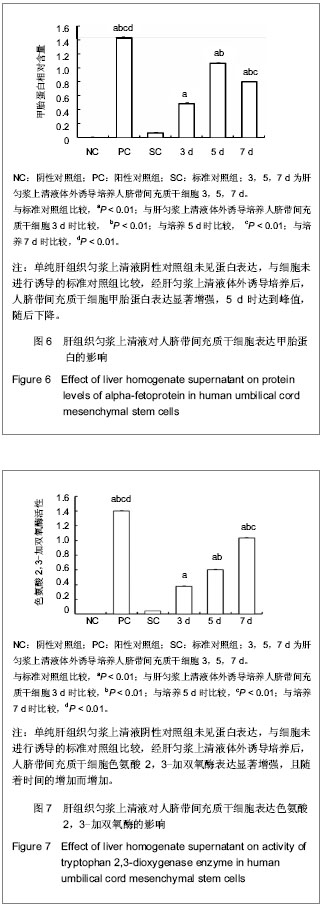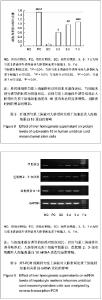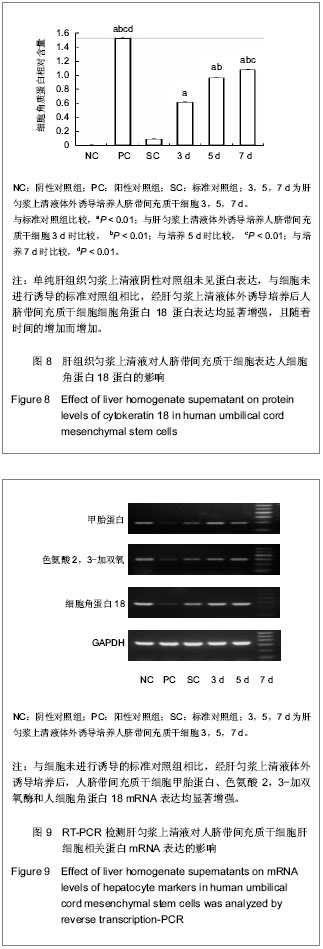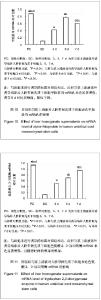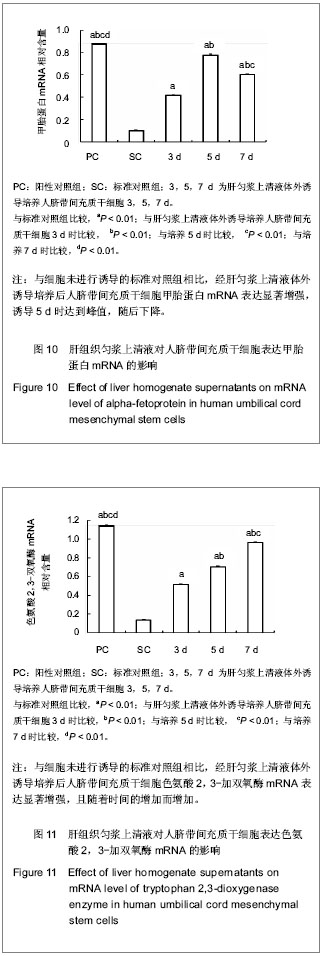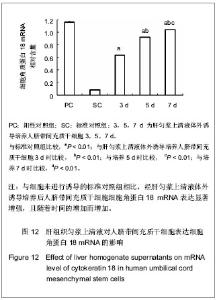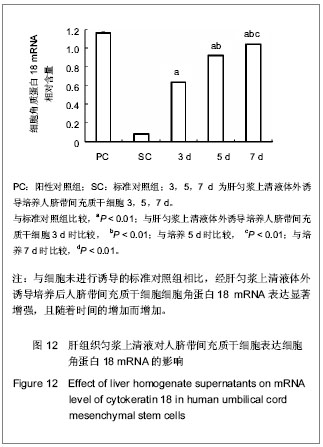| [1] Tondreau T, Meuleman N, Delforge A, et al. Mesenchymal stem cells derived from CD133-positive cells in mobilized peripheral blood and cord blood: proliferation, Oct4 expression, and plasticity. Stem Cells. 2005;23(8):1105-1112.
[2] Horiguchi S, Takahashi J, Kishi Y, et al. Neural precursor cells derived from human embryonic brain retain regional specificity. J Neurosci Res. 2004;75(6):817-824.
[3] Secco M, Zucconi E, Vieira NM, et al. Multipotent stem cells from umbilical cord: cord is richer than blood! Stem Cells. 2008;26(1):146-150.
[4] Weiss ML, Troyer DL. Stem cells in the umbilical cord. Stem Cell Rev. 2006;2(2):155-162.
[5] Lu FZ, Fujino M, Kitazawa Y, et al. Characterization and gene transfer in mesenchymal stem cells derived from human umbilical-cord blood. J Lab Clin Med. 2005;146(5):271-278.
[6] Choi KS, Shin JS, Lee JJ, et al. In vitro trans-differentiation of rat mesenchymal cells into insulin-producing cells by rat pancreatic extract. Biochem Biophys Res Commun. 2005; 330(4):1299-1305.
[7] Wang XY, Wu HH, Xue G, et al. Progesterone promotes neuronal differentiation of human umbilical cord mesenchymal stem cells in culture conditions that mimic the brain microenvironment. Neural Regen Res. 2012;7(25): 1925-1930.
[8] 王宪英,吴红海,秦亚斌,等. 脑组织匀浆诱导人脐带间充质干细胞分化为神经样细胞[J]. 中国老年学杂志,2012,32(7): 1439-1441.
[9] Puglisi MA, Saulnier N, Piscaglia AC, et al. Adipose tissue-derived mesenchymal stem cells and hepatic differentiation: old concepts and future perspectives. Eur Rev Med Pharmacol Sci. 2011;15(4):355-364.
[10] Zhou P, Wirthlin L, McGee J, et al. Contribution of human hematopoietic stem cells to liver repair. Semin Immunopathol. 2009;31(3):411-419.
[11] Lin H, Xu R, Zhang Z, et al. Implications of the immunoregulatory functions of mesenchymal stem cells in the treatment of human liver diseases. Cell Mol Immunol. 2011; 8(1):19-22.
[12] Zhao Q, Ren H, Zhu D, et al. Stem/progenitor cells in liver injury repair and regeneration. Biol Cell. 2009;101(10):557-571.
[13] Ishikawa T, Banas A, Hagiwara K, et al. Stem cells for hepatic regeneration: the role of adipose tissue derived mesenchymal stem cells. Curr Stem Cell Res Ther. 2010;5(2):182-189.
[14] Xu YQ, Liu ZC. Therapeutic potential of adult bone marrow stem cells in liver disease and delivery approaches. Stem Cell Rev. 2008;4(2):101-112.
[15] Lysy PA, Campard D, Smets F, et al. Persistence of a chimerical phenotype after hepatocyte differentiation of human bone marrow mesenchymal stem cells. Cell Prolif. 2008;41(1):36-58.
[16] Mareschi K, Ferrero I, Rustichelli D, et al. Expansion of mesenchymal stem cells isolated from pediatric and adult donor bone marrow. J Cell Biochem. 2006;97(4):744-754.
[17] Fukuchi Y, Nakajima H, Sugiyama D, et al. Human placenta-derived cells have mesenchymal stem/progenitor cell potential. Stem Cells. 2004;22(5):649-658.
[18] Banas A, Teratani T, Yamamoto Y, et al. IFATS collection: in vivo therapeutic potential of human adipose tissue mesenchymal stem cells after transplantation into mice with liver injury. Stem Cells. 2008;26(10):2705-2712.
[19] Banas A, Teratani T, Yamamoto Y, et al. Adipose tissue-derived mesenchymal stem cells as a source of human hepatocytes. Hepatology. 2007;46(1):219-228.
[20] Oyagi S, Hirose M, Kojima M, et al. Therapeutic effect of transplanting HGF-treated bone marrow mesenchymal cells into CCl4-injured rats. J Hepatol. 2006;44(4):742-748.
[21] Lee KD, Kuo TK, Whang-Peng J, et al. In vitro hepatic differentiation of human mesenchymal stem cells. Hepatology. 2004;40(6):1275-1284.
[22] 陈军,刘玉侠,姜文华,等.体外诱导人脐带间充质干细胞向肝样细胞的分化[J].中国组织工程研究与临床康复,2010,14(49): 9257-9261.
[23] Campard D, Lysy PA, Najimi M, et al. Native umbilical cord matrix stem cells express hepatic markers and differentiate into hepatocyte-like cells. Gastroenterology. 2008;134(3): 833-848.
[24] 王忠琼,李昌平,杜光红,等.多种细胞因子诱导骨髓间充质干细胞向肝细胞的分化[J].中国组织工程研究与临床康复,2008,12(21): 4035-4038.
[25] 史立军,李双星,孙博,等.骨髓基质干细胞对肝细胞与肝纤维化细胞增殖影响的体外研究[J].中华肝脏病杂志,2007,15(9): 681-684.
[26] Lange C, Bassler P, Lioznov MV, et al. Liver-specific gene expression in mesenchymal stem cells is induced by liver cells. World J Gastroenterol. 2005;11(29):4497-4504.
[27] Deng X, Chen YX, Zhang X, et al. Hepatic stellate cells modulate the differentiation of bone marrow mesenchymal stem cells into hepatocyte-like cells. J Cell Physiol. 2008; 217(1):138-144.
[28] Okumoto K, Saito T, Hattori E, et al. Differentiation of bone marrow cells into cells that express liver-specific genes in vitro: implication of the Notch signals in differentiation. Biochem Biophys Res Commun. 2003;304(4):691-695.
[29] 张世昌,王英杰,刘涛,等.脐带组织来源基质干细胞的肝细胞相关标志物分析[J].胃肠病学和肝病学杂志,2009,18(9):781-783.
[30] Zhao Q, Ren H, Li X, et al. Differentiation of human umbilical cord mesenchymal stromal cells into low immunogenic hepatocyte-like cells. Cytotherapy. 2009;11(4):414-426. |
